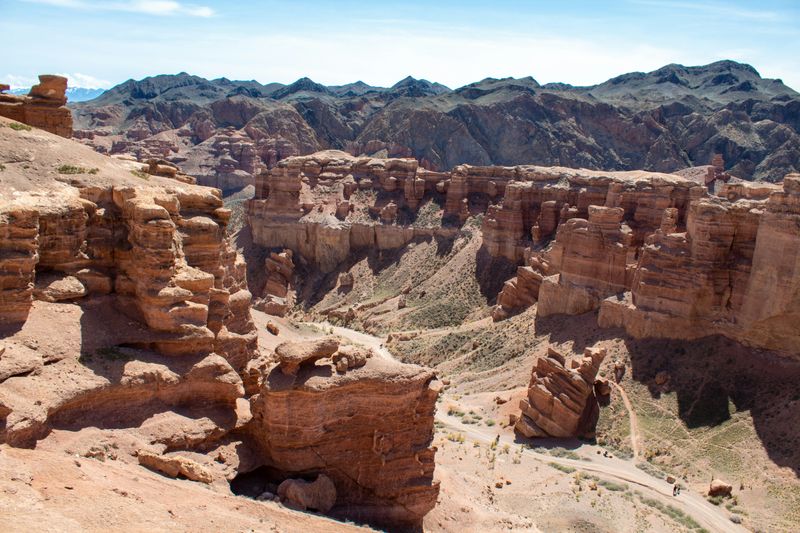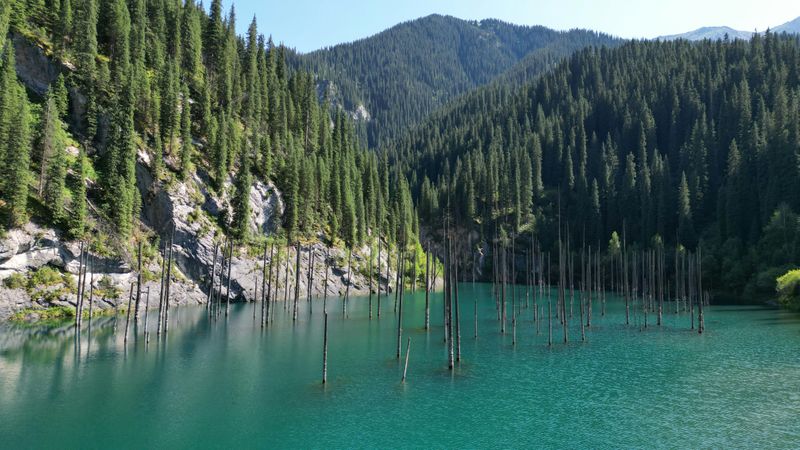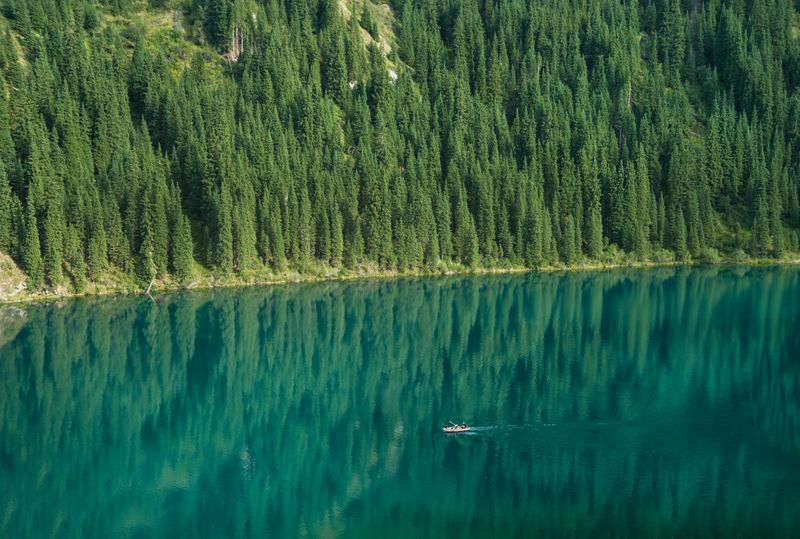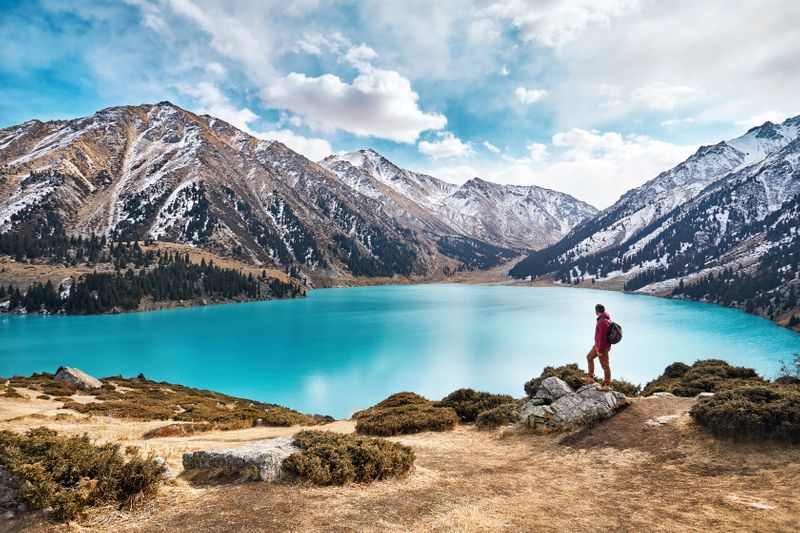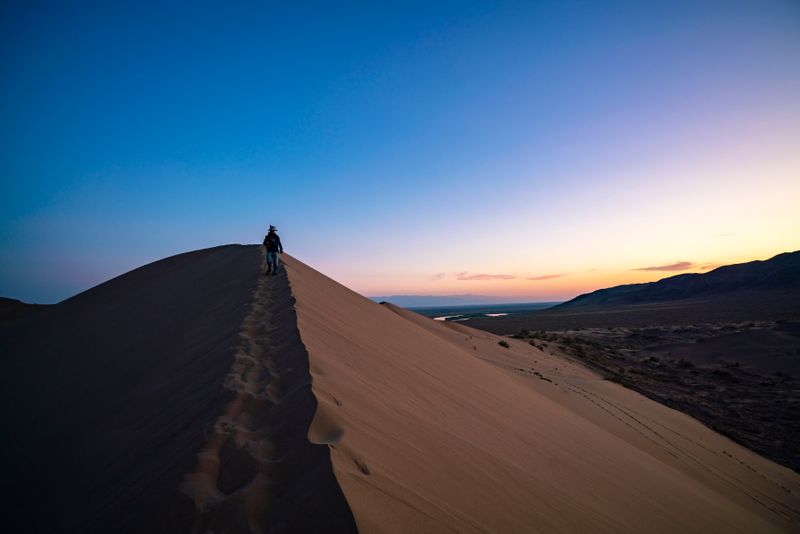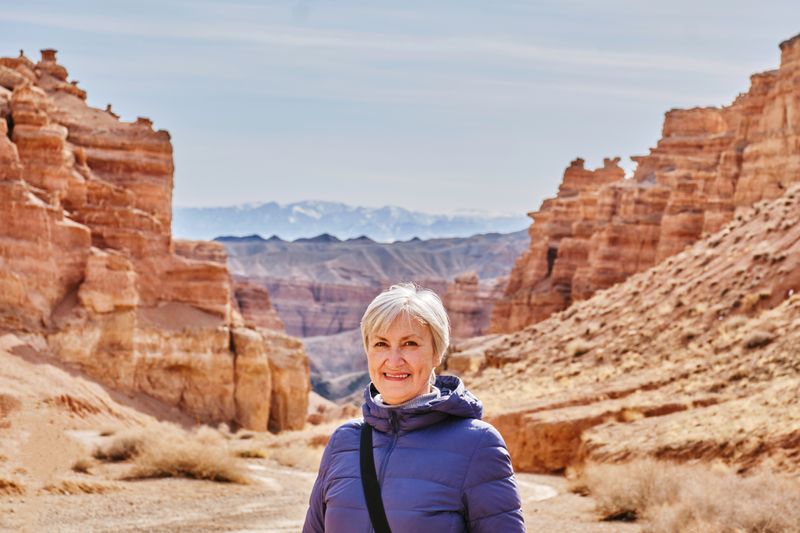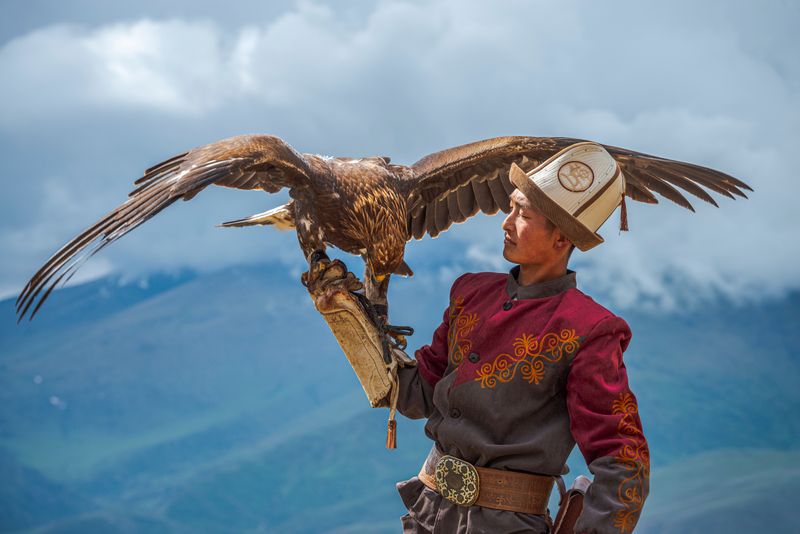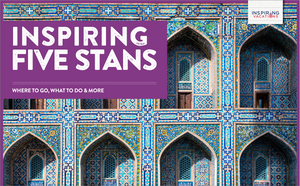Quick guide: Secret natural wonders of Kazakhstan
- Charyn Canyon: A mini Grand Canyon with colourful formations
- Lake Kaindy: A sunken forest turned glacial lake
- Kolsai Lakes: A series of pristine alpine lakes perfect for hiking
- Big Almaty Lake: Close to the city, with high-altitude alpine views
- Altyn-Emel: Home to singing dunes and rare wildlife
- Aksu-Zhabagly: Kazakhstan’s oldest reserve with wildflowers and mountain trails
- Katon-Karagay: Remote wilderness with Altai Mountain beauty
When most people think of Kazakhstan travel, they picture sprawling steppe and Soviet-era cities. But beyond Almaty’s busy streets and Astana’s futuristic skyline lies a landscape that’s wild, vast, and full of surprises. From turquoise alpine lakes and rainbow-coloured canyons to untouched mountains and hidden forests, Kazakhstan’s secret natural wonders are some of the best-kept secrets in Central Asia.
This guide highlights the best nature spots to visit in Kazakhstan, especially those lesser-known gems that offer unforgettable outdoor experiences. For travellers keen to swap crowds for silence and well-trodden routes for winding trails, these are the places worth making time for.
Kazakhstan’s most beautiful natural places to visit
Kazakhstan is the world’s ninth-largest country by land area, and much of that space is untouched wilderness. This means that many of the most beautiful sites are still considered hidden gems, even to locals. The country’s varied terrain includes steppe, alpine meadows, snow-capped peaks, and salt flats. Here’s where you’ll find some of the most spectacular spots for Kazakhstan adventure travel.
Charyn Canyon
Often called the Grand Canyon’s little cousin, Charyn Canyon is one of the most dramatic natural formations in Central Asia. Stretching for over 150 kilometres (93 miles), this colourful canyon cuts through the dry Kazakh steppe in a series of narrow gorges, towering cliffs, and twisted rock formations. Its most famous section, the Valley of Castles, gets its name from the natural towers and buttresses that resemble an ancient fortress rising from the earth. Sculpted by wind, rain, and time, the canyon’s surreal layers of reds, oranges, and ochres create a landscape that feels almost otherworldly, especially at sunrise or sunset when the rocks glow with colour.
- Best explored on foot, especially the Valley of Castles trail
- Located about 200 kilometres (124 miles) east of Almaty
- Popular for hiking, photography, and day trips from the city
Did you know?
Charyn Canyon features unique sediment layers that shift from reds and oranges to pale yellows throughout the day, depending on the sun’s angle.
Lake Kaindy
One of the most surreal Kazakhstan lakes, Lake Kaindy was formed in 1911 when an earthquake caused a massive landslide, damming a forested gorge and flooding the spruce trees that once grew there. The result is a striking alpine lake where the ghostly, bleached trunks of trees rise from crystal-clear water, creating an eerie and unforgettable scene. The water’s colour—ranging from deep blue to turquoise—only adds to its dreamlike quality, especially when framed by snow-capped peaks and evergreen forest. Reaching the lake involves a bumpy but scenic drive followed by a short walk, making the journey feel like a hidden discovery. Despite its remote feel, it’s a popular spot for photographers and hikers looking for something truly unique.
- Located in the Tian Shan Mountains, about 130 kilometres (81 miles) from Almaty
- The water is icy year-round and often glacial blue in colour
- Popular for picnicking, hiking, and photography
Did you know?
Even in summer, Lake Kaindy remains incredibly cold, which makes it more suited to scenic walks and exploration than swimming.
Kolsai Lakes
A trio of alpine lakes set deep in the Kazakhstan mountains, the Kolsai Lakes are often visited alongside Lake Kaindy and are considered one of the region’s most scenic natural attractions. Each lake offers something a little different: the lower lake is the most accessible and perfect for a relaxed day by the water; the middle lake rewards hikers with panoramic views; and the upper lake, reachable only on foot or horseback, is framed by dramatic peaks and dense pine forest. Known for their mirror-like reflections, crisp mountain air, and peaceful atmosphere, the lakes are especially stunning in early morning light. For anyone passionate about Kazakhstan hiking or photography, this area is a must.
- Lower and Middle Kolsai are accessible by car and hiking trail
- Upper Kolsai requires a multi-hour trek through forested mountain paths
- Horse rentals are available for those wanting to ride to the top
Did you know?
Locals often refer to the Kolsai Lakes as "the pearl of the Northern Tien Shan". Once you see them, you’ll understand why.
Big Almaty Lake
Just 30 kilometres (19 miles) from the city of Almaty, Big Almaty Lake is a scenic alpine reservoir set at nearly 2,500 metres (8,200 feet) above sea level. Surrounded by snow-capped peaks, pine forests, and high-altitude meadows, the lake’s setting is postcard-perfect in every season. Its vivid turquoise water shifts colour depending on the time of day and the angle of the light, creating a constantly changing scene that has become a favourite among local photographers and day-trippers. While swimming is prohibited due to its role as a drinking water source, walking trails nearby offer peaceful views and crisp mountain air. The lake is also a launching point for hikes deeper into the Ile-Alatau National Park, making it a gateway to some of the best nature in Kazakhstan.
- Easily accessed via a short drive or organised tour from Almaty
- A popular day trip for visitors seeking high-altitude views
- Best visited in late spring or early autumn
Did you know?
Big Almaty Lake also serves as a key water source for the city of Almaty and is part of a protected watershed zone.
Exploring Kazakhstan’s lesser-known national parks
Wondering where to find hidden gems in Kazakhstan? Many of them are tucked inside the country’s lesser-known national parks. These areas protect rare landscapes, wildlife, and traditional ways of life, making them some of the best places in Kazakhstan for nature lovers seeking solitude and raw beauty.
In addition to its famous canyons and lakes, Kazakhstan is home to dozens of national parks that protect unique ecosystems and endangered species. Some are surprisingly accessible from major cities, while others require a bit more effort. All offer rich rewards for the curious traveller.
1. Altyn-Emel National Park
This remote park, located northeast of Almaty, is famous for its towering singing dunes. These sand ridges create a low, rumbling hum when the wind shifts just right. Beyond the dunes, you’ll find colourful mountains, open plains with wild horses, and ancient petroglyphs etched into rocky outcrops. Altyn-Emel National Park is one of the most unique Kazakhstan nature experiences, combining desert landscapes with mountain backdrops and rich biodiversity.
2. Aksu-Zhabagly Nature Reserve
Kazakhstan’s oldest nature reserve, established in 1926, is nestled in the western Tian Shan Mountains. It’s especially beautiful in spring, when alpine meadows erupt with wildflowers. Home to snow leopards, ibex, and over 1,300 plant species, it’s a paradise for hikers and naturalists. Trails wind through deep canyons and open fields, offering views of snowy peaks and blooming valleys. This is a lesser-known but unforgettable spot for Kazakhstan tourism.
3. Katon-Karagay National Park
Located in the easternmost corner of the country, bordering Russia and China, Katon-Karagay is Kazakhstan’s largest national park. It’s home to remote alpine valleys, crystal-clear rivers, and the rugged Altai Mountains. This park is perfect for intrepid travellers looking for genuine wilderness.
- Rarely visited, making it ideal for solitude and nature photography
- Home to bears, lynxes, and even elusive snow leopards
- Offers multi-day trekking routes, fishing, and horseback riding
Kazakhstan’s size and seasonal variety mean every trip can feel different. Spring brings wildflower-strewn trails and milder weather, perfect for exploring valleys and reserves. Summer opens up high mountain routes and hidden lakes, while autumn bathes the landscape in golden hues—ideal for photography and quiet hiking. If you have extra time, consider planning a longer itinerary that links key regions like Charyn Canyon, the Kolsai Lakes, and Katon-Karagay for a more immersive journey through the country’s most stunning natural settings. Learn more about the best time to travel to Central Asia when planning your trip.
Best outdoor activities in Kazakhstan for nature lovers
If you're the kind of traveller who prefers mountain passes to museums, Kazakhstan delivers. From spring to autumn, outdoor adventures abound:
- Hiking: Through remote valleys, along riverbanks, and up to high-altitude lakes
- Camping: In national parks and alpine meadows (with or without a guide)
- Horse riding: A traditional Kazakh mode of transport, especially in mountain regions
- Birdwatching: Especially in the steppe and wetlands of central Kazakhstan
- 4WD expeditions: Across deserts, salt flats, and mountain passes
- Stargazing: Kazakhstan’s remote regions have some of the clearest night skies in Central Asia
Travel tips for visiting Kazakhstan’s natural regions
Travelling through Kazakhstan’s wilder regions requires a bit more planning, but the reward is well worth the effort.
What to pack
- Layers: Weather can shift dramatically with altitude
- Sturdy hiking boots: Especially for unpaved trails
- Cash: Remote areas may not have card facilities
- Offline maps: Phone signal can be unreliable in mountain areas
- Snacks and water: Facilities can be sparse outside major towns
- Basic first aid: It’s handy in remote locations where clinics may be far away
How to get around
- Almaty is the best base for exploring Kazakhstan’s southern landscapes. As a former capital, it offers a mix of leafy boulevards, cafes, mountain views, and Soviet-modern architecture. It’s a great city to explore before heading off-road.
- Local guides and drivers are recommended for national park visits.
- 4WD vehicles or tour groups help reach more remote areas easily.
- Public transport options are limited in remote regions, so planning ahead is key.
Plan your nature itinerary: Where to go, how long, and when
If you're limited on time:
- Big Almaty Lake — just 15 km (≈1 hour) south of Almaty. Easily accessible for a scenic half- or full-day trip.
For a weekend escape:
- Combine Lake Kaindy and the Kolsai Lakes over 2–3 days—ideal for hiking, horseback riding, and nature immersion.
For a deeper wilderness retreat:
- Visit Altyn-Emel for its singing dunes and cultural heritage—perfect for off-the-beaten-path travellers.
- Head to Aksu-Zhabagly in spring to enjoy wildflower meadows and diverse wildlife.
- Explore Katon-Karagay for multi-day treks across Altai wilderness.
Best seasons to visit:
- Spring (April–June): Blooming valleys, mild temperatures, and fewer crowds.
- Autumn (September–October): Dry weather, golden hues, and ideal light for landscapes.
Ready to experience Kazakhstan’s wild side?
From alien-like lakes to singing dunes and alpine trails, Kazakhstan travel is full of natural surprises. If you're after something beyond the usual tourist track, these hidden gems in Kazakhstan deliver unforgettable landscapes, solitude, and a true sense of discovery.
Looking to go beyond the Silk Road? Our Five Stans & Turkey Unveiled tour links the natural beauty of Kazakhstan with the rich history of Türkiye, offering an in-depth journey across Central Asia’s most fascinating regions.
Plan your nature-filled adventure today with our range of Kazakhstan tours, all carefully designed by Inspiring Vacations to help you uncover the best of Central Asia’s wilderness.
